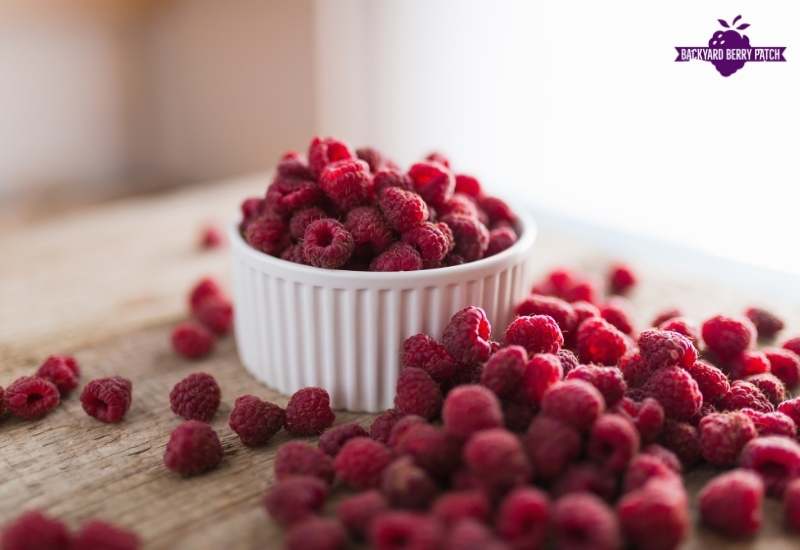Growing raspberries in Wisconsin can be a fun and rewarding hobby. These tasty berries are packed with health benefits. Plus, they can be enjoyed fresh, frozen, or used in jams and desserts.
You can successfully grow several types of raspberries in Wisconsin. These include red, black, purple, and yellow varieties.
Raspberries thrive in Wisconsin’s climate and can produce fruit for your home garden year after year. With proper care, you’ll have plenty of berries for snacking, baking delicious raspberry shortcakes, or even making homemade wine.
The key is choosing the right varieties for your specific location and growing conditions.
Whether you’re new to gardening or an experienced grower, raspberries are a great addition to your yard. They don’t require much space and can even be grown in containers. Plus, with guidance from your local UW-Extension office, you’ll have expert advice to help your raspberry patch thrive.
Wisconsin Climate And Soil Overview
Wisconsin’s climate is perfect for growing raspberries. You’ll find cold winters and warm summers here. This weather helps raspberry plants thrive.
The state has different soil types. In the north, you’ll see sandy soil. The south has rich, dark soil. Both can work for raspberries with some care.
You need well-drained soil for raspberries. If your soil is heavy clay, mix in compost to improve drainage. Add organic matter to boost fertility too.

Full sun is key for tasty berries. Pick a spot that gets at least 6 hours of sunlight daily.
In Northern Wisconsin, protect your plants from harsh winds. Use a trellis system to support the canes.
Southern Wisconsin growers, you’re in luck! The longer growing season means more berry options for you.
Mulch is your friend. It keeps weeds away and holds moisture in the soil. Try straw or wood chips around your plants.
Water is crucial. Raspberries need 1-2 inches of water weekly. In dry spells, you’ll need to water more.
Remember to space your plants well. This helps air flow and prevents disease. About 2-3 feet between plants is good.
Recommended Thornless Raspberry Varieties In Wisconsin
You’ll be happy to know that several thornless raspberry varieties can thrive in Wisconsin’s climate. These plants are easier to handle and harvest, making them perfect for your garden.
One popular option is the Canby raspberry. It’s a red raspberry cultivar that produces sweet, flavorful fruit. Canby raspberries are summer-bearing, so you’ll enjoy a bountiful harvest in July.
Another great choice is the Raspberry Shortcake variety. This compact plant is perfect if you have limited space. You can even grow it in containers on your patio!

For fall-bearing raspberries, consider trying the Joan J variety. It’s nearly thornless and produces large, tasty berries from late summer through fall.
Here’s a quick list of other thornless or nearly thornless varieties you might want to try:
- Glencoe (purple raspberry)
- Nova (red raspberry)
- Cascade Delight (red raspberry)
When planting these varieties, remember that most raspberries prefer full sun and well-drained soil. You’ll want to space your canes about 2-3 feet apart to give them room to grow.
Recommended Thorny Raspberry Varieties In Wisconsin
If you’re looking to grow thorny raspberries in Wisconsin, you’ve got some great options! These varieties are tough and can handle the state’s climate well.
Boyne is a popular choice. This summer-bearing raspberry produces sweet, medium-sized berries. You’ll love its hardiness and resistance to many common diseases.
Another excellent pick is Killarney. It gives you bright red, flavorful fruit. This variety is known for its vigorous growth and good yield.
For black raspberries, try Jewel. While it’s best suited for southern Wisconsin, it offers large, glossy berries with a rich flavor.
Here’s a quick comparison:
| Variety | Berry Color | Harvest Time |
|---|---|---|
| Boyne | Red | Mid-season |
| Killarney | Red | Early to mid-season |
| Jewel | Black | Mid-season |
Remember, proper care is key for healthy plants.
Prune your raspberries yearly and use trellising to support the canes. This helps with air circulation and makes harvesting easier.
Keep an eye out for pests like Japanese beetles and spotted wing drosophila.
Regular checks and proper pest management will help keep your plants thriving.

Leave a Reply